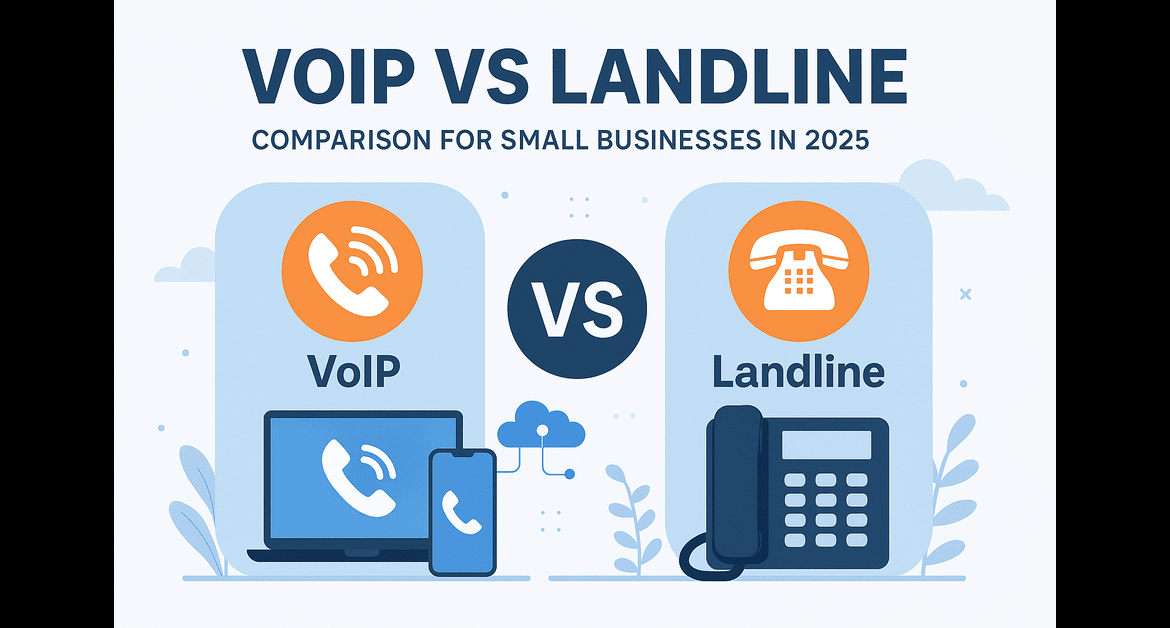VoIP vs landline is a key question for small businesses planning communications upgrades in 2025. The way small businesses communicate is rapidly evolving. With hybrid work models, remote teams, and increasing customer expectations, choosing the right phone system in 2025 isn’t just a tech decision — it’s a strategic one. For many small and growing companies, the debate boils down to one question: VoIP vs landline — what’s best for small businesses in 2025?
Landlines have long been the go-to for business communication, offering simplicity and reliability. But as digital transformation accelerates, VoIP (Voice over Internet Protocol) has become the leading choice for flexibility, scalability, and cost savings.
In this guide, we’ll break down the pros and cons of both options, explain what’s changed in 2025, and help you determine which solution is best aligned with your goals. Whether you’re launching a new business or upgrading legacy systems, this comparison will help you make a confident, future-proof choice.
What Is VoIP and How Does It Work?
VoIP (Voice over Internet Protocol) is a communication technology that allows you to make voice calls using an internet connection instead of a traditional phone line. Instead of transmitting your voice over copper wires, VoIP converts your voice into digital signals that travel over your broadband connection.
For small businesses, VoIP offers far more than just voice calls. Modern VoIP platforms come with a wide range of features like:
- Auto-attendants
- Call forwarding and routing
- Voicemail-to-email
- Video conferencing
- SMS messaging
- Analytics and call reporting
- Integration with CRMs and help desks
All of these tools are delivered over the cloud, meaning you can manage your phone system from anywhere — whether you’re in the office, at home, or on the go.
Most VoIP providers offer softphone apps for desktop and mobile, giving users the flexibility to make and receive calls from any internet-connected device. That’s a major advantage for today’s hybrid and remote work environments.
Why VoIP vs Landline Matters More Than Ever in 2025
The VoIP vs landline decision has never carried more weight than it does in 2025 — as technology, customer service expectations, and workstyles all evolve rapidly.
Before diving into comparisons, it’s important to understand how traditional landline phone systems work — and where they still hold value.
Traditional phone systems, also known as PSTN (Public Switched Telephone Network) or analog systems, rely on physical copper lines and dedicated hardware installed on-site. These systems have been the backbone of business communications for decades, and while they’ve proven reliable, they come with significant limitations in today’s fast-moving, cloud-driven business world.
✅ Pros:
- Proven Reliability: Landlines tend to work even during internet outages and power failures, especially when connected to backup power or traditional infrastructure.
- Simple Operation: Basic functionality means less technical overhead, which can be ideal for businesses that only need standard voice services.
- Local Call Quality: For businesses operating entirely within a local area, landlines may deliver consistent local call clarity.
❌ Cons:
- Limited Flexibility: Physical wiring and on-premise equipment restrict mobility. Scaling often requires expensive hardware upgrades.
- High Costs: Installation, maintenance, and long-distance calling charges can add up quickly — especially as businesses grow or operate across multiple locations.
- Lack of Modern Features: No built-in video, texting, app integration, or smart call routing.
- Difficult Remote Access: Employees can’t easily make or receive calls when away from their desks or outside the office.
Ultimately, traditional systems can still be a fit for legacy businesses in areas with poor internet connectivity — but for most small businesses today, their limitations outweigh the benefits.
VoIP for Small Businesses: Benefits That Matter in 2025
Voice over Internet Protocol (VoIP) systems have evolved rapidly over the past decade, and in 2025, they’ve become the communication standard for forward-thinking small businesses. Unlike traditional landlines, VoIP relies on your internet connection to transmit voice calls — opening the door to a range of modern features and cost efficiencies.
✅ Key Benefits of VoIP in 2025:
- Lower Costs Across the Board
VoIP systems eliminate the need for expensive hardware, maintenance, and long-distance calling charges. Many providers offer flat-rate pricing, and calls between VoIP users (even internationally) are often free. Plus, with no physical infrastructure to maintain, you reduce overhead significantly. - Built for Remote and Hybrid Work
Employees can make and receive calls from anywhere using desktop apps, mobile phones, or even tablets — all connected to the same business number. This flexibility is essential in a post-pandemic world where distributed teams are the norm.
Related: How Cloud Phone Systems Help Hybrid Teams Thrive - Rich Features That Boost Productivity
VoIP platforms come with call routing, voicemail-to-email, video conferencing, CRM integration, auto-attendants, call analytics, and more — out of the box. These tools help small teams work smarter, reduce manual tasks, and serve customers better. - Easy Scalability Without Downtime
Adding a new user is often as simple as sending a login — no tech visit or rewiring required. Whether you’re hiring new staff or opening a second location, VoIP adapts instantly. - Business Continuity and Redundancy
In the event of a local outage or emergency, VoIP calls can be rerouted automatically to mobile devices or remote users. Providers also host services in multiple, redundant data centers to maximize uptime. - Integration With Business Tools
Most VoIP platforms now integrate seamlessly with CRM software, project management platforms, and collaboration tools like Microsoft Teams or Slack — streamlining workflows and improving customer interactions.
✅ Bonus: It Grows With You
Whether you’re a solo entrepreneur or scaling to 50+ employees, VoIP can match your growth. Providers often offer pricing tiers, feature upgrades, and optional services like UCaaS (Unified Communications as a Service) when you’re ready to take the next step.
VoIP vs Landline: Side-by-Side Comparison for Small Business Owners
To make an informed decision, it helps to look at the key differences between VoIP vs traditional landline systems in a clear, side-by-side format. Here’s how they stack up in 2025:
| Feature | VoIP | Traditional Landline |
|---|---|---|
| Technology | Internet-based | Copper wire/PBX system |
| Setup Cost | Low (minimal hardware) | High (wiring, PBX, handsets) |
| Monthly Cost | Low, often flat-rate | High, especially for long-distance |
| Scalability | Instantly scalable | Requires physical setup and service calls |
| Call Quality | HD quality with sufficient bandwidth | Consistent but lacks HD clarity |
| Remote Work | Fully supported with mobile apps | Limited or requires call forwarding |
| Features | Rich (voicemail-to-email, auto-attendants, CRM integration) | Basic (call waiting, voicemail) |
| Maintenance | Minimal, cloud-managed | On-premise support required |
| Business Continuity | Auto-rerouting, geographic redundancy | Vulnerable to outages and emergencies |
| Security | Encrypted, compliance-ready (e.g., HIPAA) | Limited security features |
Bottom Line:
VoIP offers superior flexibility, modern features, and a lower total cost of ownership for small businesses — especially those operating in remote or hybrid work environments. Traditional landlines, while reliable in the past, are now outdated and costly to maintain.
How to Choose the Right Phone System for Your Business (VoIP vs traditional phone systems)
Deciding between VoIP vs landline isn’t just about cost — it’s about aligning your communication tools with your business needs. Here’s a framework to help you make the right choice:
1. Assess Your Work Environment
Are you a fully remote or hybrid team? If so, VoIP is the clear winner. It allows your team to stay connected via desktop, mobile, or browser-based apps from anywhere with an internet connection.
Brick-and-mortar businesses with no remote staff might consider landlines — but even then, modern VoIP features often offer better efficiency and service.
2. Evaluate Call Volume and Features
If your business handles high call volumes, VoIP features like auto-attendants, call queues, and analytics can help you manage calls more effectively. These features are either expensive or unavailable with landlines.
Need CRM integration, voicemail transcription, or video conferencing? VoIP systems are built for these modern workflows.
3. Consider Your Growth Plans
Adding a new team member or location with VoIP is often as simple as assigning a user license — no new lines, no hardware installations. Traditional systems may require physical rewiring and a technician visit, which slows your growth and adds cost.
4. Analyze Total Cost of Ownership
Landline systems can come with hidden fees — hardware, service calls, long-distance charges, and more. VoIP services are typically subscription-based, with predictable monthly costs and minimal hardware required.
If you’re unsure, compare offers using a transparent VoIP pricing calculator (like this one from Ringcentral) to estimate savings based on your usage.
5. Prioritize Security and Reliability
Today’s VoIP providers offer advanced security protocols, geographic redundancy, and 99.999% uptime guarantees — but not all are created equal. Be sure to ask the right questions. Our VoIP buyer’s checklist breaks down exactly what to look for in a provider.
Final Verdict: VoIP vs Traditional — What’s Best for Small Businesses in 2025?
For most small businesses in 2025, VoIP is the smarter, more scalable, and cost-effective solution. It supports hybrid teams, enables mobility, integrates with your tools, and delivers enterprise-level features without the overhead of legacy hardware.
That said, traditional landlines still have a place in certain industries — especially those with minimal tech needs or in areas with unreliable internet. But as high-speed connectivity becomes more widespread, the advantages of VoIP are hard to ignore.
Ultimately, when weighing VoIP vs landline in 2025, small businesses should prioritize flexibility, mobility, and long-term cost savings.
Still weighing VoIP vs landline for your business communications? Check out our guide on How Cloud Phone Systems Help Hybrid Teams Thrive to explore how modern communication tools support today’s work environments.
Ready to Upgrade Your Phone System?
TeleCloud offers feature-rich VoIP solutions designed for small and growing businesses. From free consultations to white-glove onboarding, we help you every step of the way.





